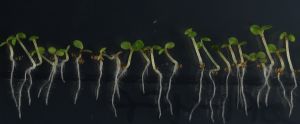Los investigadores han identificado el papel fundamental de la proteína COP1 como promotor del crecimiento de las plantas de Arabidopsis en días largos y temperaturas ambientes elevadas y su interacción con otros factores celulares. Estos datos han servido para el desarrollo de un modelo matemático que incorpora los niveles activos de estos factores y el crecimiento del tallo embrionario (el hipocótilo). Al detectar un aumento de la temperatura, la primera respuesta de la planta es la elongación del hipocótilo, para facilitar el enfriamiento de las hojas y minimizar el daño producido por el calor. Ares, investigador del CNB-CSIC explica “utilizando varias líneas mutantes de Arabidopsis en diversas condiciones de luz y temperatura, pudimos ajustar los parámetros de las ecuaciones con los datos experimentales de longitud del hipocótilo y una de las predicciones más interesantes del modelo es la que destaca que la máxima actividad de COP1 tiene lugar durante el día y a temperaturas elevadas.”
Y se hizo la luz
La temperatura promueve el crecimiento de las plantas y la luz lo inhibe. En verano, cuando los días son largos y más cálidos, las plantas reciben información contradictoria y tienen que decidir a qué señal hacer caso. “Hasta el momento, COP1 había sido descrito como un factor fundamental para regular el crecimiento en oscuridad, por lo que esta predicción resultaba insólita” señala Cristina Nieto, primera autora del trabajo y en la actualidad investigadora del Instituto Nacional de Investigación y Tecnología Agraria y Alimentaria (INIA-CSIC). “Decidimos simular el crecimiento del hipocótilo para un rango de valores de actividad de COP1, y comprobamos experimentalmente las predicciones obtenidas con mutantes donde COP1 no funcionaba bien o con plantas que acumulaban un exceso de la proteína. Gracias a este estudio, ahora sabemos que la proteína COP1 es clave para regular la respuesta a temperatura en días largos, es decir, en verano”.
Para Prat, investigadora del CSIC ahora en el Centro de Investigación en Agrigenómica (CRAG), CSIC-IRTA-UAB-UB, la importancia de este trabajo va más allá de la caracterización de las bases moleculares de la termomorfogénesis. “Las especies cultivadas muestran una variabilidad genética muy reducida en cuanto a su capacidad de adaptación a temperaturas ambientes elevadas, las cuales disminuyen su rendimiento. Aquí mostramos que formas más activas de COP1 mejoran la tolerancia al cambio climático de los cultivos que requieren días largos”.
Referencia Científica
Cristina Nieto, Pablo Catalán, Luis Miguel Luengo, Martina Legris, Vadir López-Salmerón, Jean Michel Davière, Jorge J. Casal, Saúl Ares, Salomé Prat. COP1 dynamics integrate conflicting seasonal light and thermal cues in the control of Arabidopsis elongation. Science Advances 8, eabp8412; 2022
DOI: 10.1126/sciadv.abp8412






